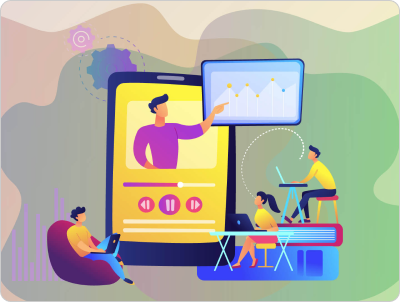Animation in Education
by Vineith Kaul, Posted on 30 December 2020

Animation is one of the best ways of making education engaging and interactive. When your most favorite cartoon characters teach you the science laws and trigonometric equations, it makes learning fun and interesting. Apart from this, animating the concepts makes it real, and when you are able to visualize something you understand it better. Also visual and verbal communication increases the retention power of the students.
Most educational institutions have their educational content in the form of animated videos, and these are the most-watched videos every year. However, it needs to be used appropriately for best results.
How to Make Animation in Education Work?
In order to bear fruitful outcomes, animation in education should follow the following rules:
Select the Right Content
It is beneficial to select the important content while publishing it online. Lengthy content with unnecessary information fails to engage the audience. Focussing on the main information enhances the interest of the students and helps them grasp the big picture.
Select the Right Style
Animations are of several types:
- 2D animation
- 3D animation
- Infographics
- Hand-drawn
- Motion graphics
The course should be designed as per the interests of the audience. Different types of learners have their own tastes in animations. For eg., k-12 students would like cartoon animations, the corporate employees would be more interested in motion graphics or infographics. This helps in providing valuable content that attracts the target audience.
Animation in Education Makes Creativity
Creative animation ideas can help you attract a large number of students. Even the most complicated and academic topics can be fun through animation. You can explain the concept through motivational stories. Use humor in the content to make the audience stick to the video. You can experiment and see which form of animation is more appealing to the audience.
Reasons to Use Animation in Classrooms
Animations shall be used in the classrooms for the following reasons:
Students Can Relate to the Animated Characters
Every kid loves animation. A child is immersed in cartoons the whole day outside schools. Their ability to relate to fictional characters enhances their ability to relate to one another. It improves their social and critical thinking skills and helps them build healthy relationships.
Animation Teaches Empathy
Researches suggest that reading books to kids is an ideal way to instill empathy in them. This is because books involve a character that the kids like and relate to. Animations work in a similar manner. Every animated video involves a fictional character, and seeing and hearing its emotions helps them develop better interpersonal skills.
Animation In Education Convey Information Efficiently
Most of the animated stories teach a powerful lesson in just a few minutes. The animated songs and poems have a long-lasting impact on the students. They get completely engrossed in the character’s tone, expressions, body language, and the words spoken by the animated characters. Thus, the information you want to convey is transferred to them easily.
Students Imitate the Behaviour of the Fictional Character
The students are so influenced by their favorite fictional characters that they start imitating them, whether it is eating spinach like the Popeye or fighting like the Power Rangers. Thus, animation is the best way to teach the students the best behaviors by providing them the videos of the characters with behaviors we want them to imbibe.
Thus animations provide a better learning experience and yield better learning results. It enables personalized learning. A little bit of creativity and imagination can make the animation work to its full potential.
1 Comments
Leave a reply
your email address will not be published. required fields are marked *








 8 Important Tips for EdTech Companies to Expand
8 Important Tips for EdTech Companies to Expand  Augmented Reality vs Virtual Reality
Augmented Reality vs Virtual Reality 
Google Reply
GoogleThe time to study or pay a visit to the subject material or web sites we have linked to below.